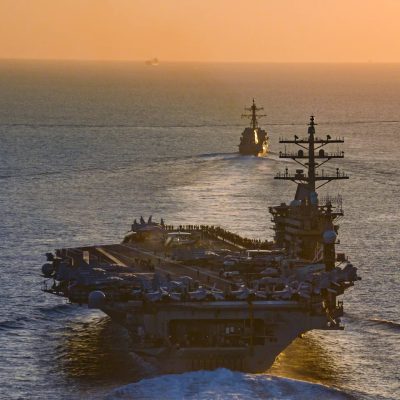
The US is now the world’s laggard in warship construction, lagging behind most countries in the pace of building military vessels, The Wall Street Journal reported. The US Navy is not struggling alone, though, with close ally Britain not even able to sufficiently replace munitions sent to Ukraine.
“When a Wisconsin shipyard won the contract to build a new class of Navy frigate in 2020, the project was meant to address an embarrassing reality: The US is now the global laggard in building warships,” the article noted.
According to the publication, US military shipbuilding faces several challenges, including outdated equipment in shipyards and labor shortages. In addition, the 25% tariffs on aluminum and steel imports from all countries previously imposed by the US could likely increase the cost of domestically produced materials used by shipbuilders.
An interlocutor familiar with the work schedule told the newspaper that the construction of the new warship USS Constellation, which was supposed to be completed by 2026, is currently only 10% complete.
The Wall Street Journal stressed that the construction delays were caused by the intervention of the US Navy, which wanted to improve the design.
“A blizzard of design changes by the military have put production of the USS Constellation years behind schedule and millions over budget,” the article elaborated.
Furthermore, the publication added that the US is already behind most countries in building warships. Thus, the newspaper concluded that of the 20 different frigates constructed recently or nearly completed by other countries, all but one were or will be built faster than the USS Constellation.
It is recalled that the Government Accountability Office (GAO) revealed on January 31 that the US Navy is struggling to keep its surface combat ships in good condition due to a lack of resources in recent years. The main problems include a shortage of spare parts and qualified personnel and the postponement of maintenance.
According to the report, the US Navy received only about $1 billion of the $24.9 billion requested for maintenance between 2020 and 2023. The difficulty continued throughout 2024.
“The Navy still faces persistent challenges sustaining combat surface ships, including limited spare parts, a lack of sufficient and qualified maintenance personnel, and a continual need to defer maintenance,” the report said.
The Navy issued 46 recommendations for improving vessels, but none of them were implemented. One example is the availability of sufficient materials for a ship to be ready for use when needed.
Amid the US Navy’s difficulties, The National Interest magazine published an article that revealed Russian Project 885M Yasen-M submarines can suddenly fire at US submarines at close range.
“The Yasen-M is meant for close combat with rival submarines. Utilizing its ultra-quiet rigging, these sea monsters can tailgate American or NATO subs, perhaps completely undetected, and then spring an attack on them with their 533 mm torpedoes,” the article said.
The National Interest also believes the same can be said about attacks on surface ships.
“The US Navy (and the navies of its NATO allies) are totally outmatched by the firepower of the Russian Northern Fleet’s Yasen-M-class submarines,” the publication noted.
However, not only did the US Navy face significant issues but also major ally Britain, with the Royal Navy not even sufficiently armed.
Prospect Magazine reported last month that the Royal Navy’s munitions were “running perilously low” as those sent to Ukraine were not yet “adequately replaced,” adding that the fleet of surface ships is “threadbare” and the nuclear submarines “are aging, with Dreadnought-class replacements not expected until the 2030s.”
While the Royal Navy is “threadbare,” China, in comparison, has built ships with a combined displacement greater than the entire British Royal Navy in four years as Beijing becomes a global maritime power.
Between 2019 and 2023, four of China’s main shipyards produced at least 39 warships with a combined displacement of around 550,000 tons. According to the Center for Strategic and International Studies, this is more than the British Navy’s battle force fleet, which has 19 surface ships and 10 submarines with a total displacement of approximately 440,000 tons.
It is also worth noting that the Chinese People’s Liberation Army Navy already has more military vessels than the US Navy and is on track to have a fleet of 425 units by 2030, significantly more than the 300 expected by the US. In 2022, the Chinese Navy operated a fleet of 351 combat force ships, compared with the US Navy’s 294. However, for now, the US holds an advantage in destroyers and guided missile cruisers.
Nonetheless, the struggles of the US and British navies show that the Anglo Alliance no longer rules the seas. While the US and Britain lag, the Russian and Chinese navies are burgeoning, and it does not appear that the situation will improve in the short term for the Anglo Alliance.
*
Click the share button below to email/forward this article. Follow us on Instagram and X and subscribe to our Telegram Channel. Feel free to repost Global Research articles with proper attribution.
This article was originally published on InfoBrics.
Ahmed Adel is a Cairo-based geopolitics and political economy researcher. He is a regular contributor to Global Research.
Featured image: USS Dwight D. Eisenhower and strike group transit the Strait of Gibraltar into the Mediterranean Sea, 28 October, 2023 (Credit: U.S. Navy)
Global Research is a reader-funded media. We do not accept any funding from corporations or governments. Help us stay afloat. Click the image below to make a one-time or recurring donation.

Comment on Global Research Articles on our Facebook page
Become a Member of Global Research
Source link

